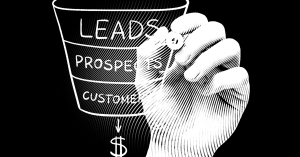
Optimizing buyer enablement
Optimizing buyer enablement You may be wondering how to entice customers to buy your product. There are a few key things you can do to
In this blog post, we’ll take a look at the evolution of B2B sales and how it’s affected how sales teams operate today. Stay tuned as we’ll dive deeper into each stage of the evolution!

Mads Winther

Sales teams have come a long way in the last few decades. From cold calls and door-to-door sales to building relationships through social media and online channels, the modern B2B sales professional has had to adapt to a changing marketplace.
There are a number of reasons why sales have evolved over the years. One of the primary drivers has been the changing nature of the business landscape. With more and more businesses moving online, the way customers buy products and services has changed dramatically. In addition, advances in technology have made it easier for customers to research and purchase products and services online. This has led to a shift in power from businesses to consumers, and as a result, businesses have had to adapt their sales strategies to meet the needs of modern customers.
Another factor that has influenced the evolution of sales is the rise of social media. Social media has given businesses a new way to connect with customers and build relationships. In addition , it has allowed businesses to more easily track customer sentiment and identify potential leads.
Finally, the recession of 2008 played a role in the evolution of sales. With businesses struggling to stay afloat, they turned to sales teams to help drive revenue. This led to a focus on efficiency and effectiveness, and sales teams had to find ways to produce results with limited resources.
With the rise of online channels and social media, traditional sales teams have gone the way of the dinosaurs. In their place, we’ve seen the rise of modern sales teams that use a variety of online channels to connect with customers. This includes using social media, LinkedIn, and other online channels to build relationships and identify potential leads. In addition, sales teams are using content marketing to produce valuable content that can be used to attract potential customers.
Content marketing is a key component of the modern sales process. By producing valuable content, sales teams can attract potential customers and build relationships with them. In addition, content can be used to educate customers about your products and services and help them make decisions about whether to purchase them.
The bottom line is that content marketing has become an essential part of the modern sales process
The bottom line is that content marketing has become an essential part of the modern sales process and should be a key component of any sales team’s strategy.
The future of sales looks bright, and there are a number of trends that we can expect to see over the next few years. One trend is the continued rise of social media. Social media has already proven to be a powerful tool for sales teams, and we can expect to see even more businesses using social media to connect with customers.
Another trend is the increasing use of mobile devices. With the growth of mobile internet usage, sales teams will need to make sure their websites and content are optimized for mobile devices.
Finally, we can expect to see a continued focus on efficiency and effectiveness. Sales teams will need to find ways to produce results with limited resources, and they will need to become more efficient in their operations.
One of the biggest changes is that buying and selling will move increasingly online. More and more transactions will take place through virtual channels, and sales teams will need to be comfortable with selling online. In addition, buyers will expect faster delivery of products and services, so companies will need to be able to provide a quick turnaround time.
Another big change is that customers will become increasingly choosy about what they buy. They’ll demand higher quality products and services, and they’ll be less likely to purchase from companies that don’t meet their standards. As a result, businesses will need to focus on quality and customer service in order to stay competitive.
The first stage of the evolution of B2B sales was the era of cold calling and door-to-door sales. In this stage, sales professionals would make a list of potential customers and then reach out to them by phone or in person. This was a time-consuming process with a low success rate, but it was only when the power began to shift to consumers that B2B sales began to change.
The second stage of the evolution of B2B sales was the era of relationship selling. In this stage, sales teams began to focus on building relationships with their customers before trying to sell them anything. This was a more effective approach, but it still relied heavily on face-to-face interactions.
The third stage of the evolution of B2B sales is the era of account-based selling. In this stage, sales teams are focused on selling to specific accounts that they believe are a good match for their products and services. This approach is more targeted and personalized than the ‘spray & pray’ method of the past.
The fourth and final stage of the evolution of B2B sales is the era of digital selling. In this stage, sales teams are using technology to reach and engage with their customers. This includes everything from social media to online marketplaces. This enabled the buyer with several options to purchase the product online without having to meet anybody. It provided the consumer with the greatest ROI ever. Time.
The evolution of B2B sales is going to continue, and sales teams will need to keep up with the latest trends in order to stay competitive. In particular, they’ll need to focus on building relationships with their customers online, using digital channels such as social media and online marketplaces. This will allow them to reach more potential customers who are ready to buy.
The future of B2B sales is looking bright. Sales teams that are willing to adapt and change with the times will be successful in reaching their target market. Technology has made it easier than ever for buyers to make informed decisions, so sales reps need to find new ways to connect with customers and provide value.
In short, the B2B sales process is changing rapidly, and it’s likely to continue evolving in the years ahead. Companies need to be prepared for these changes if they want to stay competitive in the marketplace.
Thanks for reading! We hope you found this blog post helpful. Stay tuned for more posts on the evolution of B2B sales!
If you’d like to stay on top of the evolution of B2B sales, join our community at The Playbook House where we’ve created a sales playbook box for B2B sales team to make their lives easier as it includes a community with video tutorials, free templates for building playbook elements, examples, weekly live events, FAQs, and an online forum.
Those who join our community will have access to the latest tips, tricks, and strategies for enhancing their B2B sales skills. We look forward to helping you reach your business goals!
A Sales Playbook is the go-to tool for you and your sales team when you want to built and implement a repeatable, scalable, and profitable sales motion

Optimizing buyer enablement You may be wondering how to entice customers to buy your product. There are a few key things you can do to

Developing a sales pipeline Sales pipelines are often thought of as being exclusively for sales teams, but the truth is that they can be just

The future of B2B sales is hybrid As the world of business evolves, so too does the way that companies sell to one another. In

The Playbook House ApS – Solbakken 38 – 9210 Aalborg SO – Denmark – CVR DK43114611
Copyright © 2022 The Playbook House ApS. All rights reserved